|
Metropolis (comics)
Metropolis is a fictional city appearing in American comic books published by DC Comics, best known as the home of Superman and his closest allies and some of his foes. First appearing by name in Action Comics #16 (Sept. 1939), Metropolis is depicted as a prosperous and massive city in the Northeastern United States, in close proximity to Gotham City. In recent years, it has been stated to be located in New York.[1] The co-creator and original artist of Superman, Joe Shuster, modeled the Metropolis skyline after Toronto, where he was born and lived until he was ten.[2] Since then, however, the look and feel of Metropolis has been greatly influenced by New York City.[3][4][5] Within the DC Universe, Metropolis is depicted as being one of the largest and wealthiest cities in the world, having a population of 11 million citizens.[6][7][8] In addition to Superman, the city has also been home to other superheroes, such as Booster Gold and Black Lightning. Creation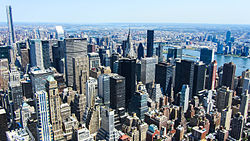 Like many other fictional cities in DC Comics, the location of Metropolis has varied over the years but is usually portrayed as a major city in the Northeast, sharing various qualities with New York City.[5] Superman co-creator Joe Shuster moved to Cleveland at age ten, where he met co-creator and Ohio native Jerry Siegel. Originally intending to sell the Superman strips to a Cleveland newspaper, they decided to set the stories there, but when the strips were re-used for the comic books, they changed the location to the fictional Metropolis. Shuster was quoted as having modeled his Metropolis cityscape on that of his hometown, Toronto,[9] and in the early versions of Superman, Clark Kent worked for a newspaper called the Daily Star, modeled after the real-life Toronto Star.[9][10] Action Comics #2, however, mistakenly portrays Clark Kent as a reporter for the Cleveland Evening News. GeographyIn Superman #2 (Fall 1939), Metropolis was actually placed in the U.S. state of New York, making it the earliest specific reference to the location of Metropolis.[5] In that issue, Clark Kent (Superman) sends a telegram to George Taylor, the editor of the Daily Star (the antecedent to the Daily Planet), addressed to "Metropolis, N.Y."[5] In the 1940s Superman cartoons, produced by Paramount Pictures, Fleischer Studios and Famous Studios, Superman is said to live on the island of Manhattan. In the seventh cartoon of the series, Electric Earthquake (1942), a Native American mad scientist claims that his people are the rightful owners of Manhattan, thus placing these cartoons on the island. In the fifth cartoon in the series, The Bulleteers (1942), the name of the city is identified as Metropolis, as the Bulleteers address in that cartoon the population of Superman's city as "citizens of Metropolis"; and in the thirteenth cartoon Destruction, Inc. (1942), Metropolis is even seen spelled out twice on the Metropolis Munition Works. In a 1970s edition of "Ask the Answer Man", a column that ran occasionally in DC publications, it was stated that Metropolis and Gotham City were adjacent to New York City; across the harbor from each other.[11] That same column stated that Green Arrow's home, Star City, was in Connecticut, Flash's Central City was in Ohio, and Hawkman's Midway City was in Michigan.[11] An earlier issue of DC's fanzine Amazing World of DC Comics, however, stated that Metropolis was located in Delaware, while Gotham was placed in New Jersey.[12] The 1990 Atlas of the DC Universe role playing game supplement, published by Mayfair Games, states that Metropolis is in Delaware.[13] In June 1976, Superman #300 featured an out-of-canon story about the infant Kal-El arriving on Earth in that year, triggering an increase in Cold War tensions between the United States and the Soviet Union. In that story's version of the year 2001, passing reference is made to the merging of the eastern seaboard cities from Boston to Washington, D.C., into a "newly incorporated urban center" called "Metropolis". In his 1978 work, The Great Superman Book, an encyclopedia of the first forty years of the Superman comics, author Michael Fleisher cites many examples which demonstrate that Metropolis equates with New York City. The most blatant of these might be the statement he cites from Action Comics #143 (April 1950), which states that the Statue of Liberty stands in "Metropolis Harbor".[3] The Statue of Liberty, in fact, stands in New York Harbor. In the pre-Crisis on Infinite Earths comics, Smallville was often shown as being within driving distance of Metropolis,[14][15] although with no definitive location. John Byrne's 1986 revamp of Superman cited the city as being in Kansas. The 1992 "Death of Superman" storyline depicts Doomsday on a path from Ohio through the state of New York, ending in Metropolis, and the 2005 comic Countdown to Infinite Crisis also places Metropolis in the state of New York. The 2003 DC Comics/Marvel Comics crossover mini-series JLA/Avengers depicts the city as along the multi-state Interstate 95, which is the main highway on the East Coast of the United States,[16] and portrays the corresponding location in the Marvel Universe as forests and fields, explaining that Marvel's Earth and DC's Earth have different surface areas to account for their different geography (no Metropolis on Marvel's Earth, no Latveria on DC's Earth, and so on).[17] On the television series Superman: The Animated Series, the second part of the episode titled "Little Girl Lost" depicts Darkseid's minion using a machine hidden in or around Metropolis to attempt to pull a comet into the earth. The beam from that machine is depicted originating from the area of the mid-western United States where Kansas is located. In the second part of the episode "Last Son of Krypton" when Lois is introduced to Clark Kent, she is told he is from Smallville, she replies "Smallville? Never heard of it", prompting Clark Kent to ask her if she had ever been to Kansas. Lois replies "God No!" while turning her head in a sign of visible disgust. Frank Miller has said that "Metropolis is New York in the daytime; Gotham City is New York at night."[4][18] Gotham City is home to Batman, whose activities are more often nocturnal, while Metropolis is home to Superman, who usually operates during the day. In terms of atmosphere, Batman writer and editor Dennis O'Neil has said that, figuratively, "Batman's Gotham City is Manhattan below 14th Street at eleven minutes past midnight on the coldest night in November, and Metropolis is Manhattan between 14th and 110th Streets on the brightest, sunniest July day of the year".[18][19] New York City has been more recently used as a locale in the DC Universe, like the Marvel Universe, in which it exists as a separate city from Metropolis and Gotham City. The Justice Society of America, for example, is based in New York, as were the Teen Titans. In relation to Gotham City Metropolis is frequently depicted as being within driving distance of Gotham City, home of Batman. This happens, for example, in the three-issue 1990 mini-series of World's Finest Comics by Dave Gibbons, Steve Rude, and Karl Kesel. The distance between the two cities has varied greatly over the years, ranging from being hundreds of miles apart to Gotham and Metropolis being twin cities on opposite sides of Delaware Bay, with Metropolis in Delaware[13][20] and Gotham City being in New Jersey.[21][22][23][24][25][26] In Bronze Age stories that depicted Metropolis and Gotham City as twin cities, the Metro-Narrows Bridge was said to be the main route connecting Metropolis to Gotham City.[14][27] Stated as being the longest suspension bridge in the world,[28] the Metro-Narrows Bridge is likely based on the Verrazano-Narrows Bridge, which stretches between Staten Island and Brooklyn in New York City. In The World's Greatest Superheroes newspaper comic strip, a 1978 Sunday strip shows a map of the east coast of the United States; the map places Metropolis in Delaware and Gotham City across Delaware Bay in New Jersey, with the Metro-Narrows Bridge linking the two cities.[29] A similar map appeared in The New Adventures of Superboy #22 (October 1981), with Smallville shown within driving distance of both cities (in post-Crisis comics, Smallville was officially relocated to Kansas). 1990's The Atlas of the DC Universe also places Metropolis in Delaware and Gotham City in New Jersey.[21] However, the exact location of the two cities has varied. A map of the United States in the Secret Files & Origins Guide to the DC Universe 2000 depicts Metropolis and Gotham City (alongside Blüdhaven) as being somewhere in the tri-state area.[30] In the TV series Lois & Clark: The New Adventures of Superman, when Lois finds out about Superman's secret identity and yells at Clark about how he's been hiding his secretly being Superman, he responds, "A little louder, Lois. I don't think they could hear you in Gotham City." In the TV series Smallville, Linda Lake, a columnist for the Daily Planet, once boasted that she could see Gotham City from her new office.[31] In Superman: The Animated Series, Bruce Wayne is shown taking his private jet aircraft to Metropolis, indicating that the two cities have at least some distance between them. In the 2016 film Batman v Superman: Dawn of Justice, director Zack Snyder confirmed that Metropolis and Gotham City would be portrayed as geographically situated right next to each other, on the opposite sides of a bay, similar to Jersey City and Manhattan.[32] HistoryA Native American tribe sold Metropolis Island to the first European settlers in 1644,[33] similar to the history of New York City, in which Native Americans sold Manhattan Island to Dutch settlers in 1626.[34] FeaturesOver the years, Metropolis' features have greatly changed in the comics; however, Metropolis is always presented as being a global city. It is often referred to as "The Big Apricot" just as New York City is nicknamed "The Big Apple".[35] It is commonly portrayed as having an Art Deco style of architecture, much like New York City. The skyline and many of the notable landmarks in Metropolis are based on real-life landmarks in New York City.[3] Frank Miller has said that "Metropolis is New York in the daytime; Gotham City is New York at night."[18] Metropolis' features became more defined and more obviously based on New York following both 1985's Crisis on Infinite Earths miniseries and John Byrne's subsequent revamping of Superman, including the late 1980s comic special The World of Metropolis. According to Action Comics #143 (April 1950), the Statue of Liberty is said to stand in "Metropolis Harbor", while the real-life Statue of Liberty stands in New York Harbor.[3] However, most stories indicate the Statue of Liberty is actually in New York City, which also exists in the DC Universe as a separate city from Metropolis. The map of Metropolis designed for Mayfair Games' first edition of the DC Heroes Role-Playing Game resembled that of Manhattan. Districts and boroughsMetropolis is made up of six boroughs, the largest being New Troy. Each of the boroughs has its own distinct character and feel, which resemble and mimic New York City's boroughs. New TroyNew Troy is the largest borough in Metropolis. Resembling Manhattan, New Troy is a skyscraper island bustling with commerce and business. The concrete and steel canyons of the city rise to dizzying heights. "1930s architecture stretched like a rubber band" as cited in the Art of Superman Returns book. The Daily Planet Building is the most recognizable landmark in the Metropolis skyline, much like the Empire State Building for New York City. Located in "Planet Square", it is particularly known for the Daily Planet globe atop the building. Other prominent skyscrapers include the Emperor Building (a reference to the Empire State Building), the Newstime Building (home of the national Newstime magazine, a reference to and combination of Newsweek and Time) which is secretly owned for several years by Lord Satanus posing as "Colin Thornton", and the Twin Towered LexCorp Tower, (a reference to the former twin towers of the World Trade Center), headquarters for Lex Luthor's company. 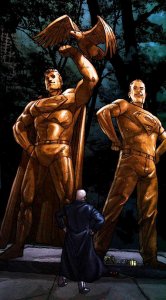 Besides the Financial District, notable areas of New Troy include:
Famous streets in New Troy include Fifth Avenue, Bessolo Boulevard, and Topaz Lane. The latter two are Metropolis' versions of Broadway in New York City. Bessolo Boulevard's name is derived from Adventures of Superman lead actor George Reeves' legal name before entering films. Other Metropolis boulevards in the New Troy borough are similarly named for other actors from that series and from its radio predecessor of the same name, such as Coates, Larson, and Collyer. Centennial Park (sometimes labeled as Metropolis Park) is Metropolis' largest city park and is based on real life Central Park of New York City. Its most noteworthy feature is a statue of Superman with an American bald eagle erected after his apparent death fighting Doomsday. A statue of Superboy (Conner Kent) was built next to it after the events of Infinite Crisis. In 1990s and 2000s stories, the married Clark Kent and Lois Lane live in an apartment in New Troy, at 1938 Sullivan Lane, which is a tribute to the year Superman first appeared. The apartment was a wedding gift to the couple by Bruce Wayne, who owned the building.[36] Clark Kent's traditional address of 344 Clinton Street, Apartment 3D, was usually described as being located in midtown Metropolis.[37] Suicide SlumIn northwestern New Troy is the impoverished and crime-infested neighborhood of Suicide Slum, best known for the 1940s adventures of the Guardian and his street urchin companions the Newsboy Legion and in more contemporary times with Gangbuster. Although the northwestern location is similar to the relationship of Harlem to midtown Manhattan, the neighborhood bears more physical and cultural resemblance to Manhattan's Lower East Side. The Ace o' Clubs is a bar owned by Bibbo Bibbowski in Suicide Slum. Other locations in New TroyOther notable places and their NYC inspirations in New Troy include:
Boroughs and suburbsNew Troy is separated from the suburban boroughs by the West River and Hobb's River, based on New York's East River and Hudson River, respectively. MidvaleMidvale is a suburb of Metropolis, more well known as the home of Supergirl and the site of the Midvale Orphanage prior to the events of Crisis on Infinite Earths.[38] It is located 60 miles northwest of Metropolis.[39] BakerlineBakerline is another borough of Metropolis. Located north of New Troy, Bakerline is the home of newspaper reporter Jimmy Olsen and appears to be based on The Bronx in New York City. Other boroughs and suburbsOther boroughs and suburban areas, almost all of which are based on real places in New York City, include Queensland Park (a reference to Queens), Hell's Gate (a reference to Hell Gate Bridge), St. Martin's Island (a reference to Staten Island), Park Ridge (a reference to Park Slope), Metrodale, and Highville. Cultural, educational, and research institutions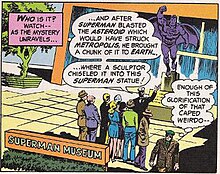 In the Silver Age and Bronze Age comics, a major Metropolis landmark is the Superman Museum.[40] The Superman Museum features various exhibits dedicated to Metropolis' favorite superhero, similar to the Flash Museum in Central City.[41] The Museum's exhibits were responsible for the origin of the Composite Superman.[42] Members of the criminal organization the 100 at one point secretly used the Superman Museum as their base of operations, which was discovered by the superhero Black Lightning and his nemesis the Whale.[43] Superman, under the effects of hypnosis, once went on a rampage and wrecked several pieces at the museum.[44] The Superman Museum, like the Flash Museum, is also usually shown as existing well into the Legion of Super-Heroes' era, as shown in various stories[45] and the 2000s television series Legion of Super Heroes. The central branch of S.T.A.R. Labs, a major scientific research institution, is also located in Metropolis.[46] The Metropolis Museum of Natural History was featured in the film Superman Returns. EducationMetropolis University, Clark Kent's alma mater, is located in the city of Metropolis; Clark graduated with a degree in journalism.[47][48] The college has a floating aquarium anchored just offshore called the "Ark".[8] Other landmarks, institutions and businesses
IndustryLexCorp, founded by Lex Luthor, is interested in all aspects of technology, communication, medical science, technical science, architectural engineering, future technology, and more.[8] Steelworks is the laboratory of Dr. John Henry Irons and in post-Crisis, it came to rival LexCorp as its reach expanded into many different industries. John Henry renamed Steelworks Ironworks to further himself from his superhero life as Steel.[8] Law and governmentMayorsAt least four mayors are considered part of Metropolis' history:
Metropolis Police DepartmentThe Metropolis Police Department headed by Commissioner David Corporon possesses a Special Crimes Unit dedicated to defending the city against superhuman menaces in case Superman is absent. The unit is headed by Maggie Sawyer and Dan Turpin, both of whom maintain frequent contact with the Man of Steel. Another of Superman's police contacts over the years has been Inspector William Henderson, who is currently the Metropolis police commissioner. The police unit is featured in a 1994–1995 limited series, Metropolis SCU. At some point during the missing year following Infinite Crisis, the division of the Metropolis Police Department dedicated to superhuman crime was renamed the Science Police, seemingly a reference to the similarly named group in the Legion of Super-Heroes' 31st Century. Stryker's Island Penitentiary (based on New York's Riker's Island) is the name of Metropolis' largest prison facility, as well as the name of the island on which it sits; it is located in Metropolis' West River south of New Troy (the real-life Riker's Island sits in the East River, connected by a foot and vehicle bridge to the nearby borough of Queens, although the island itself and its jail complex are technically and officially part of The Bronx). Metropolis Fire DepartmentPost-Crisis, Fireman Farrell is shown to be a member of the Metropolis fire department.[66] As of Batman & Superman: World's Finest #4 (July 1999), Farrell is now a captain in the Metropolis FD. MediaMetropolis' premier newspaper is the Daily Planet, one of the most renowned news organizations in the DC Universe. The city is also home to the national Newstime magazine, where Clark Kent held the position of editor during the Eradicator story arc until he was fired by his superior, Collin Thornton, in The Adventures of Superman #465, for his increasingly strange behavior due to the Eradicator (including firing of some employees). Other major media located in Metropolis include WGBS-TV, flagship station of the Galaxy Broadcasting System (GBS) television network, both subsidiaries of media conglomerate Galaxy Communications.[67] Popular shows included The Midnight Show Starring Johnny Nevada (a fictional version of NBC's The Tonight Show, with Johnny Nevada being an analogue of Johnny Carson).[68] Between the early 1970s and mid-1980s, both Clark Kent and Lois Lane worked for WGBS after Galaxy Communications purchased the Daily Planet in a 1971 storyline, with Clark as the anchorman for the WGBS evening news.[69] He was eventually joined by Lana Lang as a co-anchor.[69] After John Byrne's revamp of Superman's origins, though, Clark and Lois were reverted to working at the Daily Planet once again. Galaxy Broadcasting and WGBS-TV still exist post-Crisis, however, and are usually used in any story where a television station or network is needed or shown. Post-Crisis, Clark, Lois and Lana never worked for the station. During the 1990s however, both Jimmy Olsen and Cat Grant did work there. People and cultureThe people of Metropolis are depicted as a diverse group of large city-dwellers within the comics. They live in one of the world's largest, wealthiest, and most important cities. SportsAs befitting any world city, Metropolis is represented by teams in all major-league sports.[70] Like New York City, it is home to two teams in baseball and football. Of the two baseball teams, the Metropolis Monarchs are Clark Kent's favorite,[71] while the other team, the Metropolis Meteors, is mentioned in 52 as having a rivalry with the St. Louis Cardinals. In American football, Metropolis is home to the Metropolis Metros and the Metropolis Meteors. The latter football team (sharing the same name as the above baseball team) once featured Steve Lombard as its star quarterback.[72] On the TV show Smallville, there is a football team called the Metropolis Sharks. The city is also home to the Metropolis Generals basketball team, who play in Shuster Sports Arena,[73] presumably named for Superman co-creator Joe Shuster. Professional ice hockey is also present in Metropolis; its NHL team is the Metropolis Mammoths.[13] Several sports stadiums have been mentioned over the years. One such stadium is Metropolis Stadium, which was built in 1940. (Pre-Crisis, Metropolis Stadium had an Earth-Two counterpart, which was named "Sportsman's Stadium".)[74] This was perhaps influenced by the real-life Sportsman's Park in St. Louis, for many years the shared home of baseball's St. Louis Cardinals and St. Louis Browns. Legion-Era MetropolisMetropolis is traditionally depicted as continuing to survive, thrive and expand well into the 30th- and 31st-century timeframes used as the backdrop of the Legion of Super-Heroes in all that series' varied incarnations to date. During the original incarnation of the series, Metropolis would be depicted as covering anything ranging from the entire Atlantic American coast to a more narrowed jurisdiction – according to one map officially published during Paul Levitz and Keith Giffen's initial partnership on the series, in Legion of Super-Heroes (vol. 2) #313 (July 1984) – covering most of Massachusetts, all of Rhode Island and Connecticut, New York State from Long Island's eastern tip up into the Catskills, and a large portion of northern New Jersey. In one imaginary Superman tale published in 1976 and partly set in then-futuristic 2001, "Metropolis" is the name of the new megalopolis of the Eastern seaboard corridor, comprising the cities of Washington, D.C., Philadelphia, New York and Boston and all the territory in between (Superman #300, June 1976). Whatever version was used, it was generally viewed as given that the original city, as well as Gotham City, were considered within Legion-era Metropolis' boundaries, from the mid-1960s until the events of Zero Hour. The first post-Infinite Crisis version of the series as published in the "three-boot" edition has described Metropolis as having expanded over the intervening millennium up the "entire Atlantic seaboard" of North America in one issue (reminiscent of New York's future expansion in Isaac Asimov's The Caves of Steel and in Poul Anderson's The Corridors of Time, and to an extent Mega-City One of the Judge Dredd comics). In Final Crisis: Legion of 3 Worlds, it is revealed that this version of Metropolis belongs to the newly restored Earth-Prime's 31st Century. In Adventure Comics (vol. 2) #12, Metropolis during the Legion's first year is described by Brainiac 5 as having a population of "78 million sentient inhabitants in the urban zone before you reach the greenbelt". In other mediaTelevision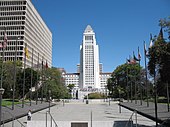
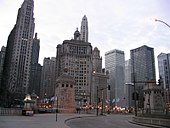

Film
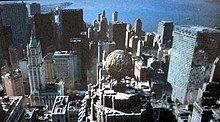 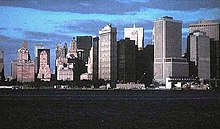 

Video gamesMetropolis appears in several video games, including Superman, Superman: Shadow of Apokolips, Superman: The Man of Steel, Superman Returns, Mortal Kombat vs. DC Universe, where it is shown partially in ruins following the Justice League's fight with Darkseid, and it appears in DC Universe Online. Metropolis appears in the game Injustice: Gods Among Us, in two different forms- a Prime Earth version, in which the Joker attempts and fails to destroy the city with an atomic bomb, and an alternate universe Earth version, which occurs as a result of the Joker succeeding in his plot, which also involved the death of Lois Lane and Superman's unborn son. The alternate universe, or "Regime" Metropolis is used as a playable fighting stage. Here, it has been rebuilt into a more dystopian city, which is where the "prime" Batman and Joker end up when they are accidentally transported there. The Prime Earth version, however, is not a playable stage in the game, and is only shown as a cameo in the game's story mode. One notable feature in each version of Metropolis is a statue depicting Superman with a globe. In the Prime universe, the statue depicts Superman standing below the globe, carrying it above his head, symbolizing that he follows the world's rules. On the other hand, in the Regime universe, the statue depicts Superman standing above the globe with his arms folded, symbolizing that the world follows his rules, as he has become a tyrant following the destruction of the original Metropolis and the deaths of Lois Lane and their unborn son. Metropolis is the only stage in the game to have three sections: the city streets, the top of the Daily Planet, and a museum featuring past superhero costumes and weapons. Metropolis appears in Lego Dimensions, where it is taken over by Sauron from The Lord of the Rings franchise, With Superman being sucked into an alternate dimension, Batman, Gandalf, and Wyldstyle oppose Sauron. Metropolis appears as a playable stage in Injustice 2. The two sections consist of Memorial Station (which contains statues of Superman and his downfall and Lex Luthor's opposition) and the Ace O' Clubs bar. In the story mode, Metropolis is one of the cities Superman fails to restore on Brainiac's ship. In Lego DC Super-Villains, part of the open world is Metropolis. LexCorp Tower, The Daily Planet, and S.T.A.R. Labs are featured. An open-world Metropolis is the main setting of Suicide Squad: Kill the Justice League, with Brainiac taking over the Justice League through mind control and having them capture and destroy the city, so he can rebuild it new. Theme parksMetropolis appears in the Justice League: Alien Invasion 3D dark ride designed and created by Sally Corporation for Warner Bros. Movie World in Gold Coast, Australia. The city also appears in the Justice League: Battle for Metropolis dark ride created by Sally Corporation and is located at several Six Flags theme parks. A section of Warner Bros. World Abu Dhabi is themed after Metropolis, with major landmarks serving as entrances to attractions such as the Daily Planet for a Superman attraction, the Hall of Justice for a Justice League ride, and the Metropolis Observatory for a Green Lantern attraction. Patrons can also eat at a restaurant themed after Big Belly Burger. Metropolis, IllinoisThe real town of Metropolis, Illinois, has been proclaimed the "hometown of Superman" by the Illinois State Legislature, and the town celebrates its "local hero". Among the ways it celebrates the character include a large Superman statue in the city, a Superman museum, an annual Superman festival, and its local newspaper The Metropolis Planet, a name inspired by the major newspaper in fictional Metropolis, the Daily Planet. A version of the town has appeared in the comics itself, as a city whose citizens idolize the hero who lives in their 'sister' city.[84] See alsoReferences
External links
|
||||||||||||||
